Key points
- Diamond rings need gentle cleaning to keep their sparkle. Mix warm water with mild dish soap in a bowl, soak the ring for 20-30 minutes, scrub it softly with a new and soft toothbrush, rinse well under warm water, and pat dry with a lint-free cloth.
- Different ring types need different care. Gold rings can be cleaned like diamonds, silver rings need anti-tarnish cloths or dips, gemstone rings can’t handle harsh cleaners or ultrasonic machines, and pearl rings should never soak in water.
- Professional cleaning is best for valuable rings once or twice a year. Jewelers use special tools and solutions that clean deeper without harming the rings.
Contents
Ring Care
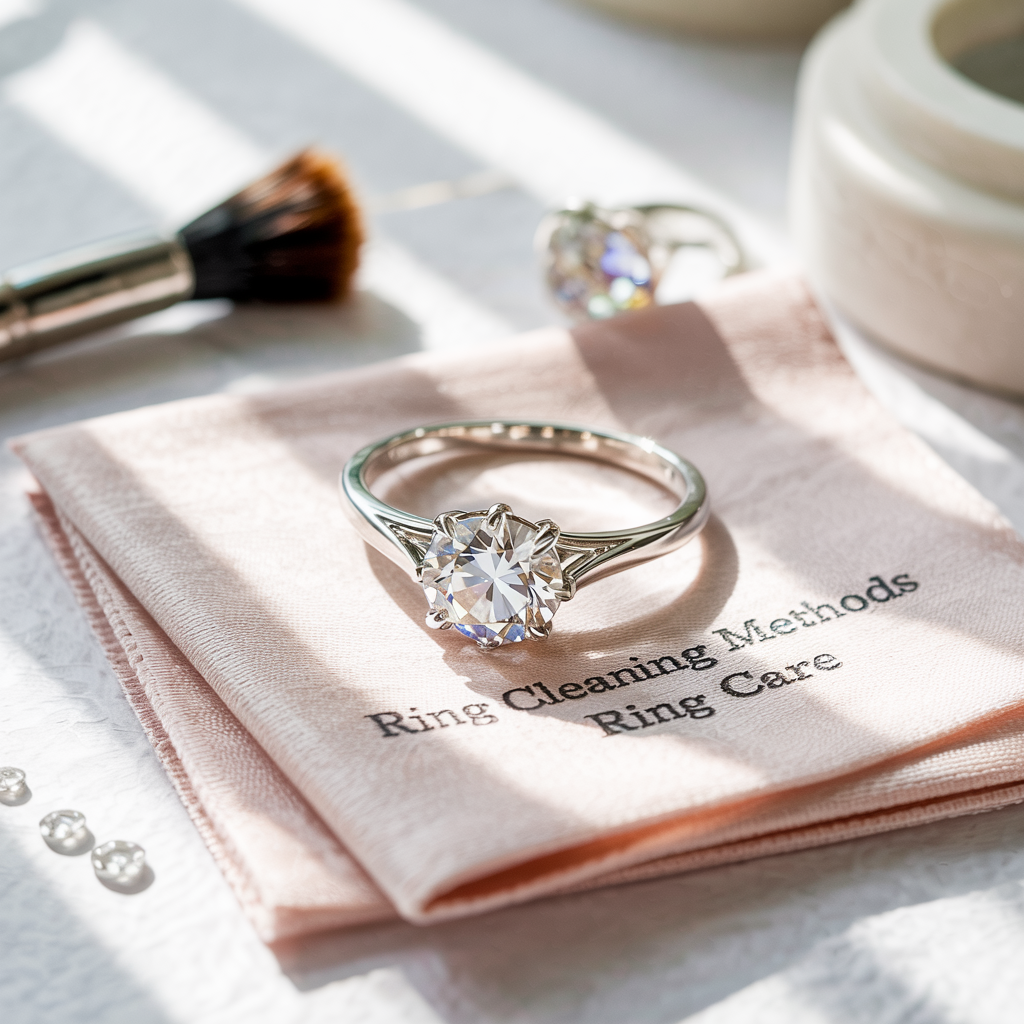
Life as a ring is tough. It gets worn while washing our hands, while cooking, and doing everything else in our lives.
Research by the Gemological Institute of America (GIA) shared that proper care of pieces of jewelry can extend their life for decades. The good news? Ring care isn’t hard once you know the basics.
Importance of Regular Cleaning
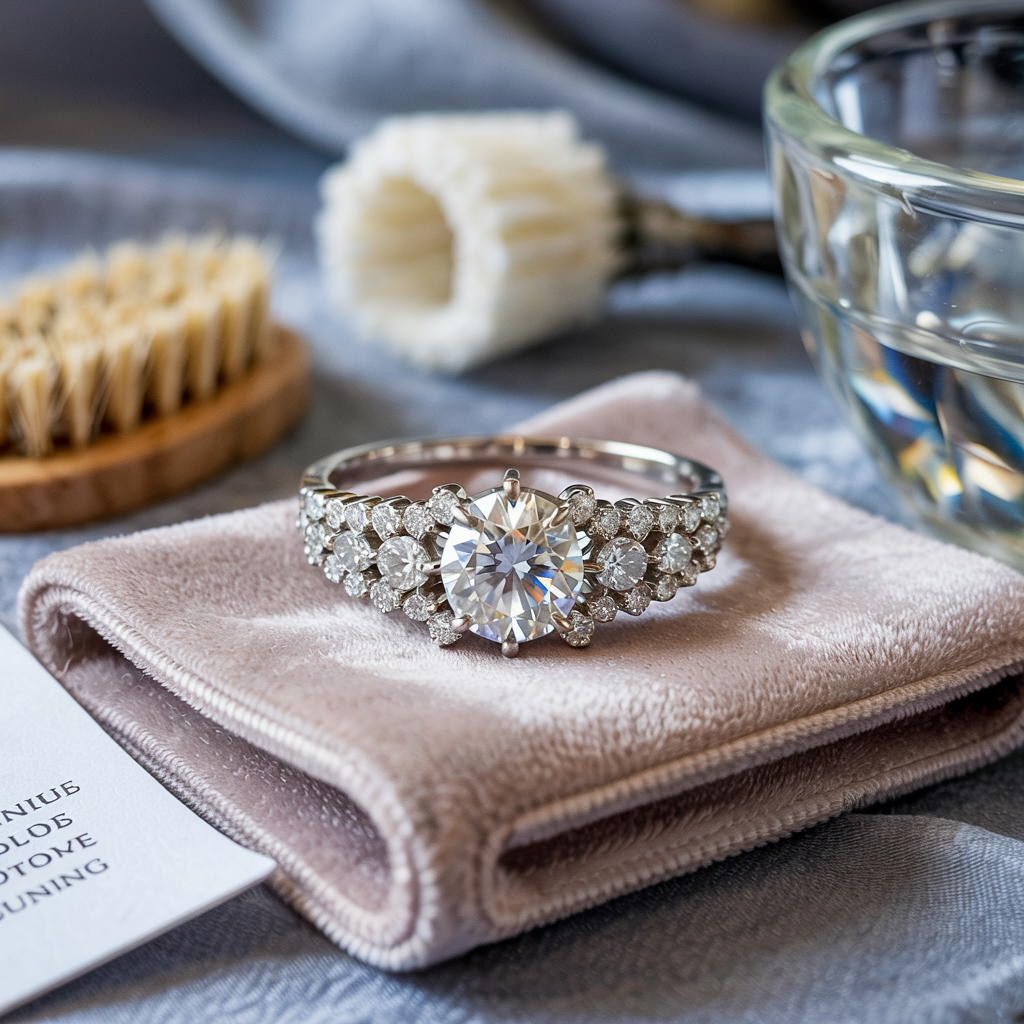
Let’s talk about why cleaning your rings matters.
Dirt and oils build up on the rings. This dirt can make stones appear dull and loosen the settings over time.
Wearing rings every day can trap bacteria and chemicals that may irritate the skin and cause infection.
This is why regular cleaning is important. It allows you to check for any loose stones or worn-out prongs before you lose the piece.
Overview of Ring Materials and Their Care Needs
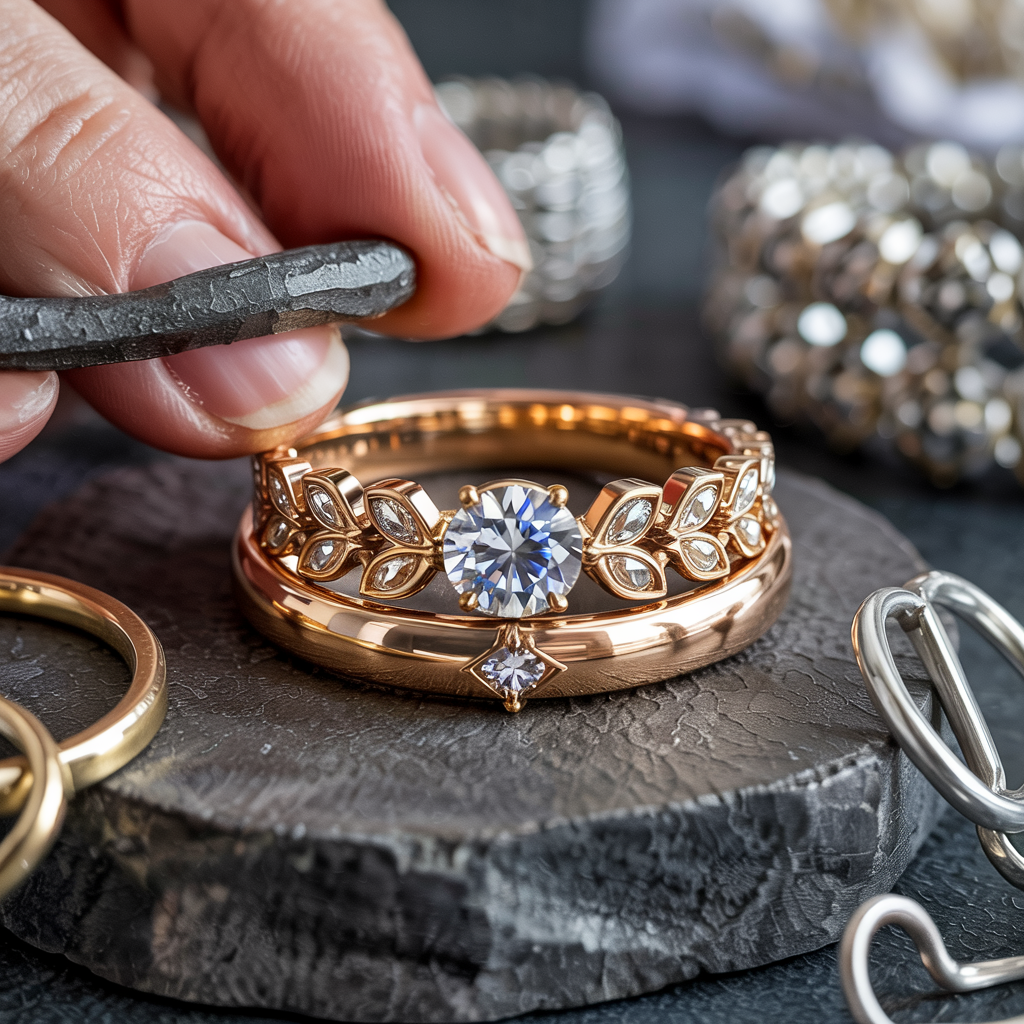
Gold rings need gentle care. Pure gold (24K) is a soft metal that scratches easily. 14K and 18K gold are stronger than 24K gold but still require some care.
Wash gold rings in warm water with mild soap. Steer clear of harsh chemicals such as chlorine and bleach. The World Gold Council (WGC) states that chlorine exposure can destroy the alloys in gold causing it to pit and get weak.
Silver
Silver tarnishes. Silver turns dark when it is mixed or comes into contact with air and sulfur. Clean silver rings with a silver cloth or silver cleaner. Put a silver anti-tarnish bag or anti-tarnish strip in your silver ring bag.
The Silver Institute states that tarnish formation can be reduced up to 70% if stored at a low temperature.
Platinum
Platinum is tough but gets scratched. Scratched platinum doesn’t lose its metal— it just moves. Clean platinum rings with mild soap and warm water. Polish with a soft cloth to keep the shine.
Gemstones
Follow these steps to restore a diamond’s brilliance at home:
- Fill a small bowl with warm (not hot) water and add a drop of mild and grease‑cutting dish soap.
- Let the jewelry soak for five minutes so dirt and oils loosen.
- Use a soft‑bristled brush. An old toothbrush works fine to scrub around prongs and facets.
- Rinse under running water.
- Pat dry with a lint‑free cloth.
Delicate gems like opals, pearls, and emeralds demand more care. Emeralds have natural fissures, opals are porous and absorb liquids, and pearls’ nacre can wear away. Never turn these beauties loose in an ultrasonic cleaner.
Cleaning Diamond Rings
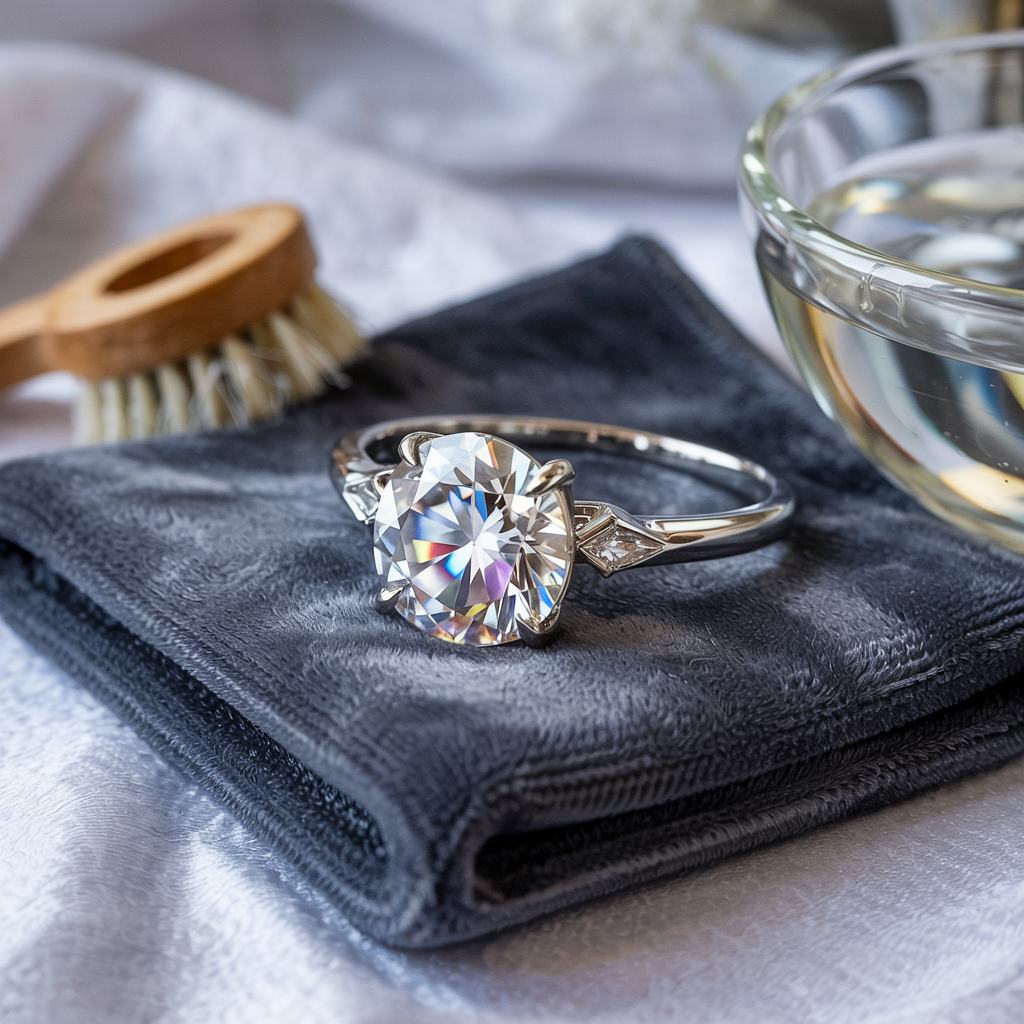
Understanding Diamond Properties
Diamonds are hard stones. They score a 10 on the Mohs hardness scale which makes them the hardest natural substance on earth (Gemological Institute of America, 2023).
Diamonds still attract oils and dirt due to daily wear. They shine beautifully because of how they reflect light. This “sparkle” comes from how they bend and bounce light.
Dirt that builds up blocks this light path. Clean diamonds shine much more brightly.
Safe Cleaning Methods for Diamonds
Here is the step-by-step process:
- Mix warm water with a tiny bit of mild dish soap in a small bowl.
- Soak the ring for 20-30 minutes.
- Use a soft, clean toothbrush to gently brush around the stone and setting.
- Rinse under warm running water.
- Dry with a lint-free cloth.
Cleaning Gold Rings
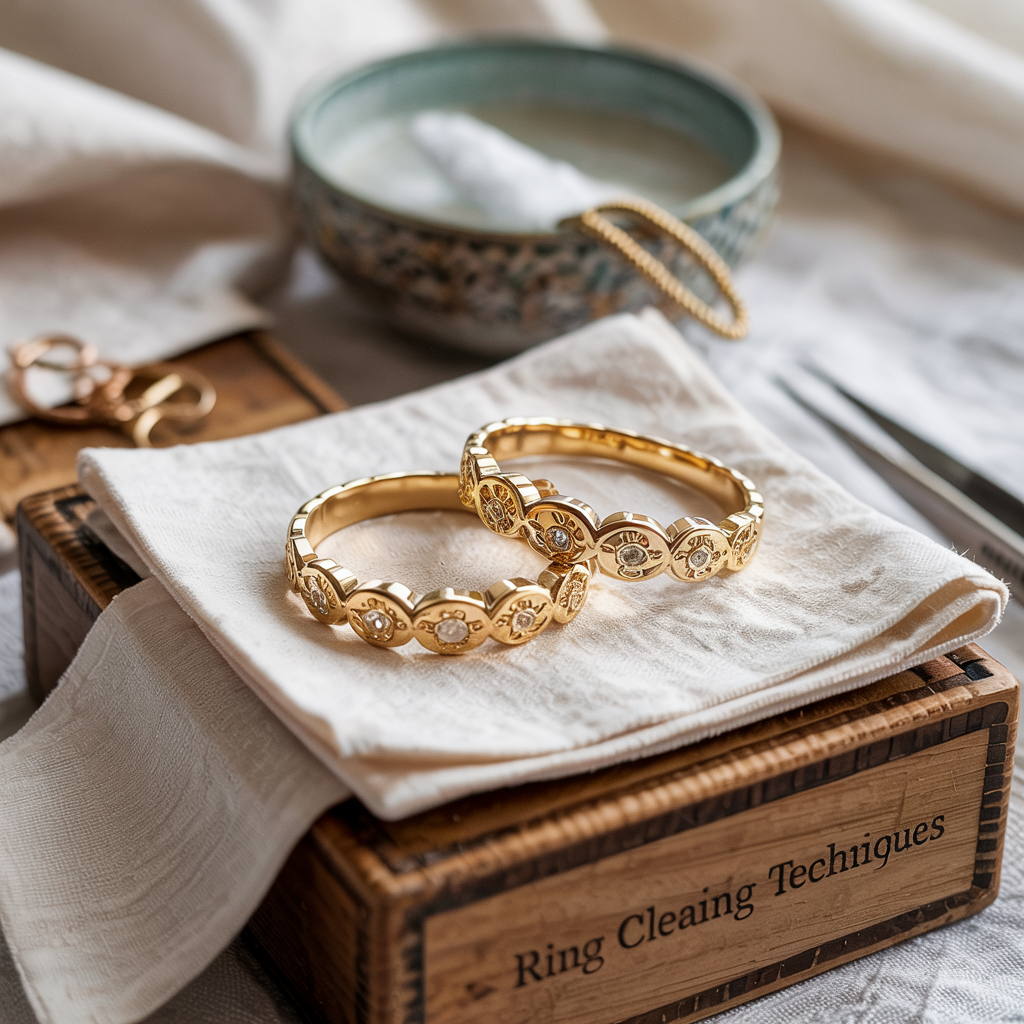
A little care goes a long way in keeping the gold shining as good as new.
Characteristics of Gold
Gold is soft. Most jewelry won’t use gold that easily bends. They use gold mixed with other metals. 24K gold will easily bend but 22K or 18K gold is much stiffer. This mixing creates different colors such as yellow, white, or rose gold.
The karat number tells you how much gold is in your ring. A 14K gold ring has 58.3% gold while an 18K has 75% gold (World Gold Council, 2021).
Higher karat gold is more yellow and softer. Lower karat gold is stronger but may tarnish more.
- White Gold: Think of white gold as gold dressed in a silvery robe. That’s the rhodium plating doing its job. Over time—usually every year to two—you’ll see a slight yellowish hue peeking through.
- Rose Gold: That warm and blush tone comes from a generous dash of copper that makes it tougher than yellow or white gold. Copper tends to develop a subtle patina (a softer and vintage‑style tarnish) if it’s exposed to moisture or harsh cleaning solutions.
Cleaning Techniques for Gold
- Basic cleaning: Mix mild dish soap with warm water. Soak your gold ring for 15-20 minutes. Brush gently with a soft toothbrush to remove dirt. Rinse well and dry with a soft cloth.
- More stubborn dirt: Add a drop of ammonia to the soap. Do not use this on gold that has gemstones on them as some gemstones do not take ammonia well.
- Harsh cleaners with bleach or chlorine: These can damage gold alloys. Ultrasonic cleaners can work for plain gold bands but may loosen stone settings further or damage fragile gems.
Preventing Scratches and Tarnish
- Store your gold rings separately to prevent scratches.
- Remove your rings before going into chlorinated pools and working with chemicals. Chlorine can damage the gold alloy rings.
- Take your rings off when putting on lotion, perfume, or hairspray. These products can build up and dull the finish.
Silver discoloration can happen to lower karat gold or 10K & 14K gold. This is because of the other metals mixed with gold. Regular cleaning prevents this buildup.
Having a white gold ring should require rhodium re-plating every few years to maintain the white finish.
Cleaning Silver Rings
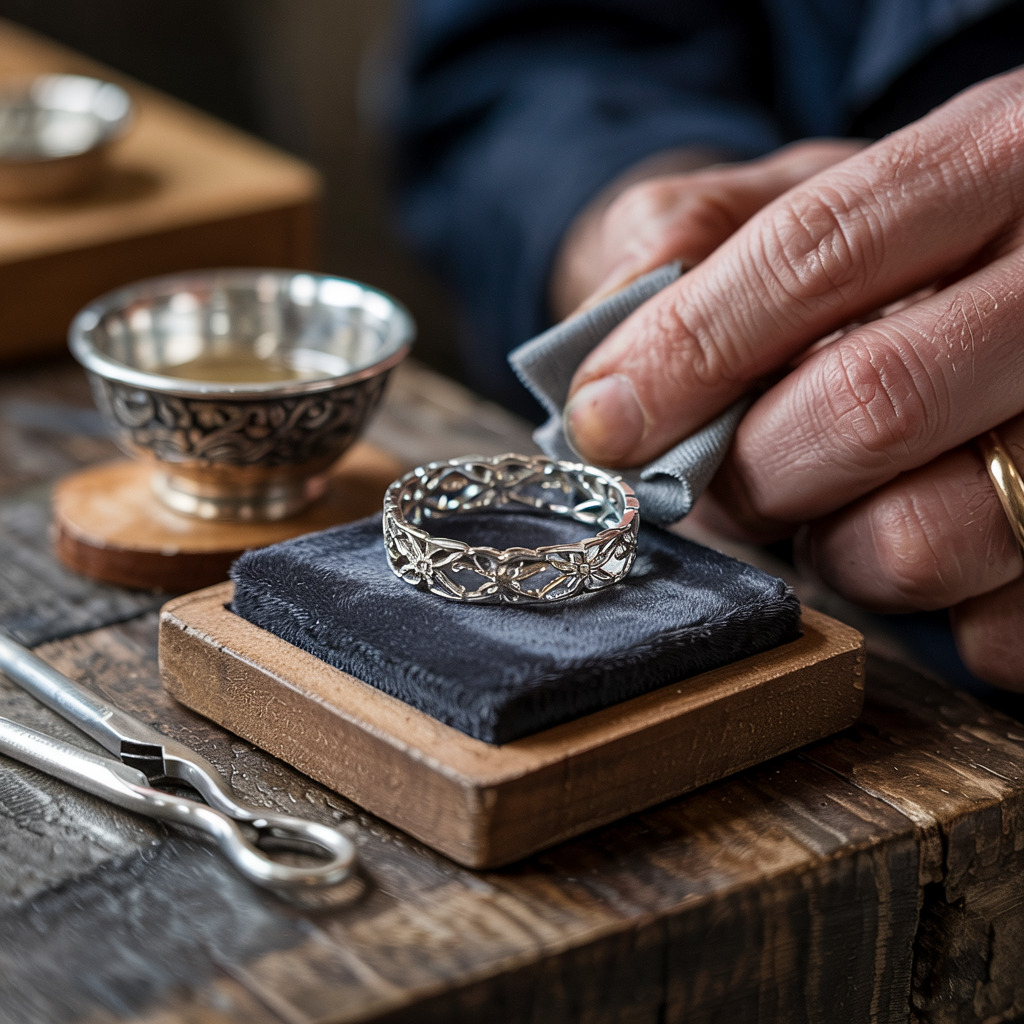
Properties of Silver
Silver is a soft metal that’s easy to shape. This softness means it can scratch easily. Fine silver is too soft to use in jewelry on an everyday basis. Most silver rings are made from “sterling silver” which is a mix of silver with metals like copper.
Sterling silver is made of almost all silver. This mixture gives rings more strength. Other metals like copper can tarnish over time because they react with air.
Research says that the sulfur present in the air makes silver tarnish black (GIA, 2019). It gets converted to silver sulfide.
Effective Silver Cleaning Methods
- Put a few drops of mild dish soap in warm water to clean silver rings. Soak your rings for 5-10 minutes. Brush them carefully with a soft toothbrush and rinse with clean water. Pat dry with a soft cloth.
- For the tough stains: Make a paste of baking soda and water. Rub it on with a soft cloth, rinse well, and dry. Baking soda is backed by a study from the Silver Institute that proves it’s effective for cleaning silver without using any popular harsh reagents.
Dealing with Tarnish
Tarnish happens when silver reacts with sulfur in the air. It shows up as a dark layer on your rings. The good news? It’s not permanent.
Light tarnish: A silver polishing cloth works wonders. Heavier tarnish: Try the aluminum foil method.
Line a bowl with aluminum foil (shiny side up). Add 1 tablespoon of baking soda and 1 tablespoon of salt. Pour in hot water. Place your silver rings in this mix for 5-10 minutes.
Cleaning Platinum Rings
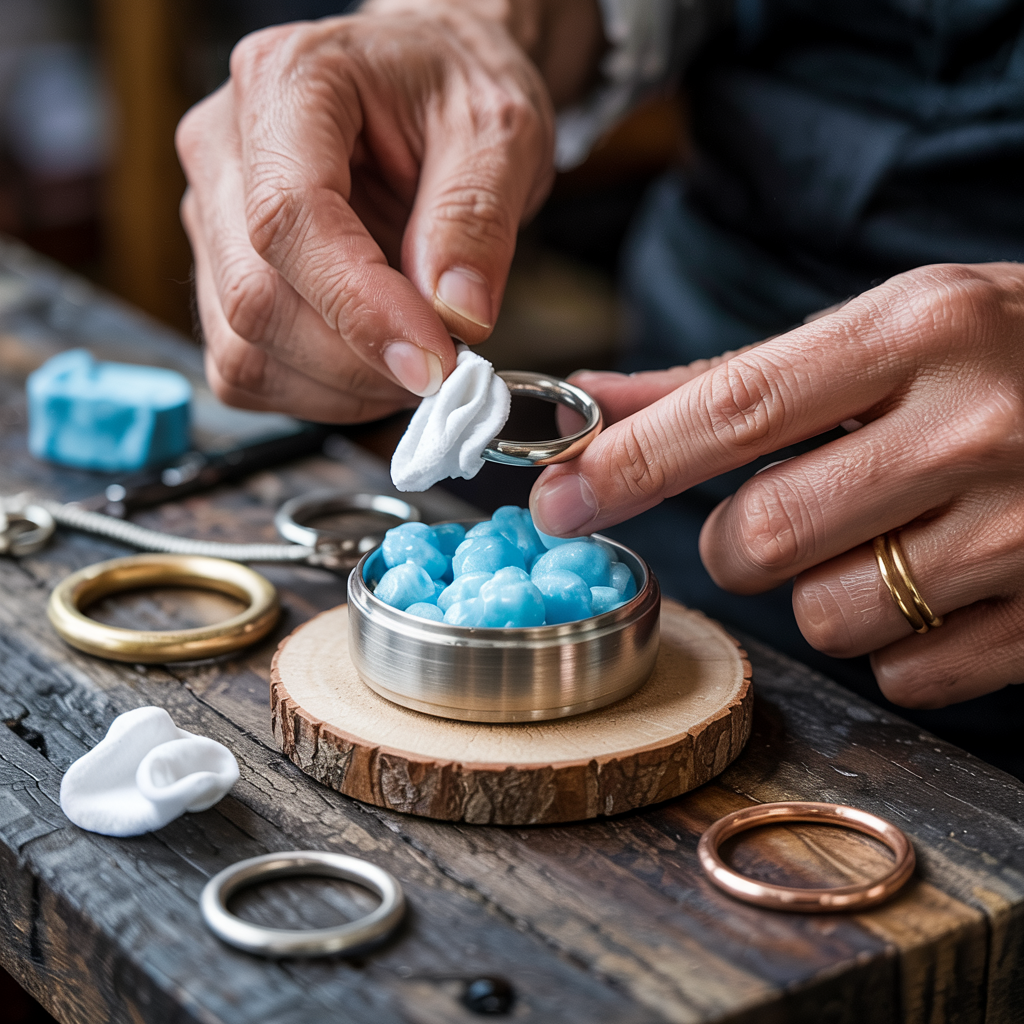
Platinum rings are unlike gold and have features that affect how we clean and maintain them.
Features of Platinum
Platinum resists corrosion. It acquires a soft and satiny bloom that many collectors like for its understated elegance. It boasts a toughness that endures daily wear without losing shape or shine.
It’s this combination of rarity—approximately thirty times scarcer than gold—and exceptional solidity that has made platinum the metal of choice for pieces meant to last generations.
Platinum jewelry carries with it both the tangible weight of Earth’s hidden treasure and the promise of timeless resilience.
Platinum is known for being hypoallergenic. This makes them perfect for everyday wear.
Maintaining Platinum’s Shine
Want to keep your platinum ring looking brand new? Regular cleaning helps maintain its luster.
Simply mix some warm water with a drop of dish soap. Give your ring a nice bath for 20 minutes. Scrub it with a toothbrush. Rinse well and dry with a lint-free cloth. Do this monthly to keep your ring looking great.
Dulling of platinum can happen over time. Gentle cleaning can stop this from happening. It will help prevent skin oils and lotion buildup on platinum.
Best Practices for Cleaning
Here are the top tips for cleaning platinum rings:
- Avoid harsh chemicals. Take off your ring before swimming or cleaning the house.
- Use the right tools. Soft brushes work best. Don’t use paper towels or tissues.
- Try ultrasonic cleaners with care. These machines may work for platinum.
- Get professional cleanings. Take your ring to a jeweler once or twice a year. They can polish it and check for loose stones or damage.
- Store properly. Store your platinum ring in a fabric-lined box away from all other pieces of jewelry.
Professional Cleaning and Maintenance
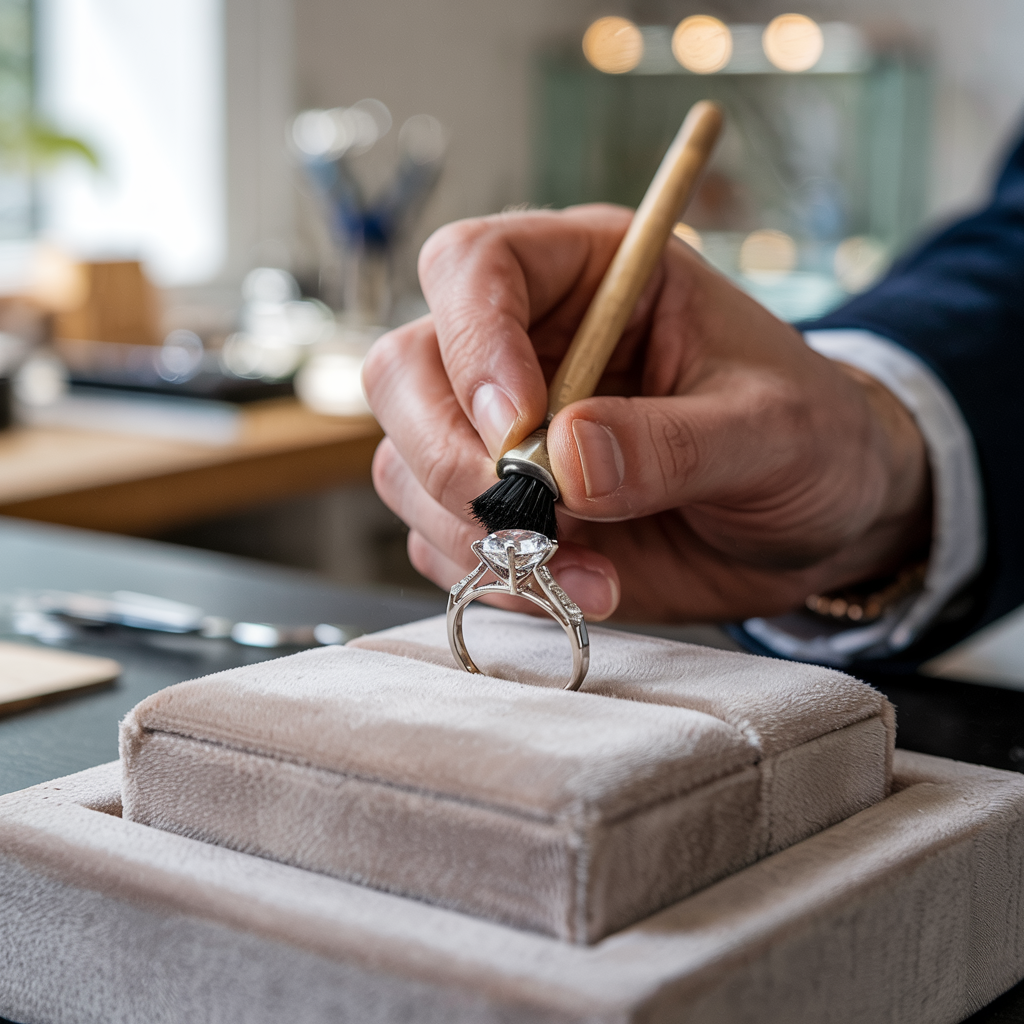
When to Seek Professional Help
Your rings need professional help when they appear dull despite your cleaning. If you see any loose stones, bent prongs, or scratches on the band, take it in.
Experts often recommend getting a professional cleaning every six months for daily rings.
Benefits of Professional Cleaning
Pro cleaning goes beyond what we can do at home. Jewelry cleaning specialists have special tools and solutions to remove dirt from all areas of the jewelry including hard-to-reach areas. Tightening of loose stones and worn settings is also done.
Selecting a Professional Jeweler
Choose a jeweler with good reviews and proper credentials. Seek certifications from the Gemological Institute of America (GIA) or the American Gem Society (AGS). Ask friends for recommendations or check online reviews.
Frequently Asked Questions (FAQ)
Is baking soda safe for cleaning jewelry?
Baking soda works well for cleaning gold jewelry but may harm softer stones and metals. Mix a bit with water to create a paste, gently scrub with a soft toothbrush, and rinse thoroughly to remove dirt remains. Anna from The Knot warns against this method on family heirloom pieces or jewelry with delicate stones like emeralds.
How often should I clean my diamond jewelry?
Diamond jewelry should be cleaned every two weeks to maintain its sparkle and prevent long-term dulling from finger oil and everyday substances. Pieces worn daily like engagement rings should have a quick cleaning bath weekly. Rings need more frequent cleaning than other items like diamond earrings since they collect more dirt through constant exposure.
Is vinegar good for cleaning diamonds?
Vinegar can be used as a household cleaning solution for diamonds in a pinch. Mix equal parts vinegar and warm water, soak your diamond ring for about 15 minutes, then gently brush with a toothbrush if dirt remains. Jewelry experts warn that this mild acid may harm certain metals like copper alloy in rose gold. It’s not ideal for all settings.
What's the difference between cleaning diamond rings and earrings?
Cleaning diamond earrings requires extra care since they have different settings and usually collect less dirt than rings. When cleaning diamond earrings use a plug in the sink to prevent losing these smaller pieces down the drain. Rings collect more oil, makeup, and lotion than earrings since they’re constantly exposed on your fingers.
Why is hydrogen peroxide controversial for diamond cleaning?
Hydrogen peroxide works as an antiseptic that can dissolve build-up on diamonds but may damage certain metals and porous stones in the process. Many jewelers consider it a no-no for regular home cleaning.
What common household products should never touch my diamonds?
Toothpaste contains abrasives that can scratch softer metals and damage the settings holding your diamonds. Avoid harsh household cleaning products containing strong acids, bleach, or chlorine which can erode metals and diminish the luster of your precious stones. Mouthwash might seem like a wonder solution for quick cleaning but its alcohol content can loosen glue in certain jewelry types and harm the appearance of more delicate pieces.

I’m Kary Walters, a wedding planner and writer with a passion for helping couples stay together and achieve their relationship goals. With over a decade of experience, I specialize in self-improvement and have worked with individuals & couples facing challenges.